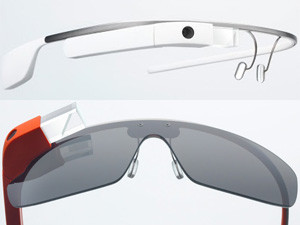
Google is continuing to pull the curtain back on the details surrounding its Google Glass project and what the final product is shaping up to be.
Google Project Glass held a developer panel at the SXSW Interactive conference on Monday, and showcased some of the first third-party apps to be integrated into Google Glass. These apps include Gmail, Evernote, Path and The New York Times (NYT).
Speaking on the panel, Google's developer advocate, Timothy Jordan, said every integrated app must adhere to four principles, namely 'design for Glass', 'don't get in the way', 'keep it timely' and 'avoid the unexpected'.
According to Jordan, the intention is to give users access to technology they enjoy, without taking them "out of the moment". All of the integrated apps also fit into the "timeline card" interface, whereby short snippets of useful information are displayed in the user's peripheral vision.
The timeline cards are conceptually similar to the cards displayed on devices running Google Now. These cards can consist of images, text or bundles of expandable data which can be accessed by tapping the side of the headset.
The apps also use the Google Mirror API to pull in the relevant information to Google Glass.
With the NYT app, breaking news is streamed straight to the Google Glass headset. Using head gestures, the user can also view photos and other headlines, and the headset can even read news stories out aloud if prompted to do so.
Google's own Gmail application for Glass allows for the user to configure which e-mails can be pushed to the headset. Incoming messages are displayed with a message subject line, as well as a picture of the sender. There is also an option to dictate a reply.
For the Path app, when a close friend shares a photo, a notification is sent to the Glass headset. The wearer can then swipe through a choice of Path emoticons and comment on the photo directly, without having to use their smartphone.
Evernote has also been working on an integrated version of its app, which allows Glass users to share photos to Skitch (an app for the visual communication of ideas). After taking a photo, the user navigates to the 'Share' option and can select Skitch directly. According to Jordan, a potential use case is taking a photo during a meeting, posting it to Skitch and annotating it later using another device, before saving it to Evernote.
While it was not one of the apps showcased at the event, Google is also said to be working with Duke University on a Glass application called InSight, which is capable of recognising people in crowds based on their clothing rather than facial recognition.
Transparent product strategy
Google first went public with the Google Glass Project in April last year, and has been open to public participation from the outset. Developer preview versions of Google Glass are already available for $1 500, and Google recently called for adventure-junkies to participate in shaping Google Glass through the 'Glass Explorer Program'.
Google has previously said it is aiming to officially launch Google Glass to the public in early 2014.
Forrester analyst Sarah Rotman Epps says Google Glass deserves plaudits for innovation. "Not just for the device itself but for the process by which Google is developing and marketing the product.
"Studying product strategy and marketing as a Forrester analyst for almost nine years, I have never seen a company do what Google is doing: launch an entirely new form factor in such a transparent, inclusive way."
According to Rotman Epps, while Google may still be months or a year away from launching a consumer product, its transparent product strategy will help to avoid the pitfalls it has had with previous product launches (such as Android which took two years to gain traction, Google TV and Chromebooks).
"Google's transparent Glass strategy not only helps Google avoid the mistakes of its own past, it's also Google's best weapon to compete against Apple. Rather than compete on Apple's terms, Google invents its own terms. It's not just "Google-level design," it's Google-level marketing. And it's working."
Next big thing
During Google's "#ifihadglass" social media campaign, it called for public submissions on what capabilities they would like to see in the device. The campaign was a runaway success, receiving thousands of suggestions over the course of just one weekend.
"Google product strategists and marketers don't have to guess what excites people about their product ? they already know," says Rotman Epps.
"Glass will be the next great platform to innovate for and should be on every company's radar. Glass will be the next Pinterest, Facebook, Amazon, and iPhone all rolled into one."
It's not all positive for Google Glass though, as a dive bar in Seattle, the 5 Point Caf'e, has already announced it is banning the use of the device on its premises - before it's even been publicly released.
The concern is that Google Glass users will be able to take photos and videos via their headsets in public locations and private situations that could invade the privacy of others and pose a security risk.
Google has responded to these concerns saying: "It is still very early days for Glass, and we expect that as with other new technologies, such as cellphones, behaviours and social norms will develop over time."
Share